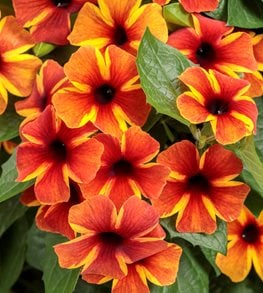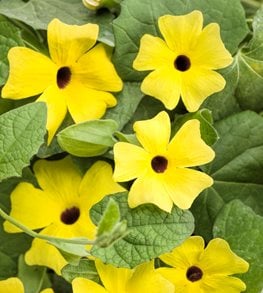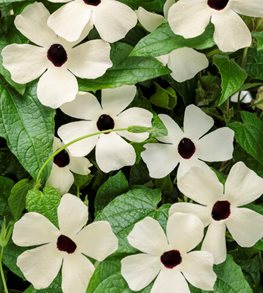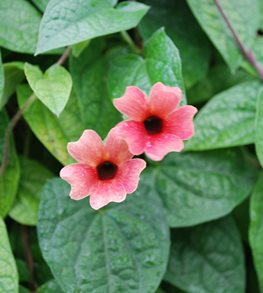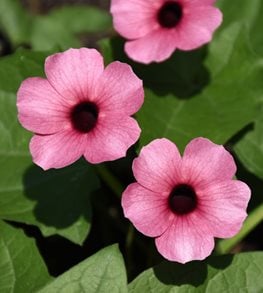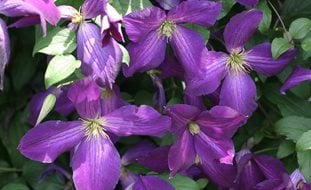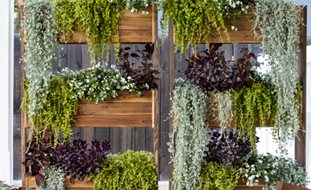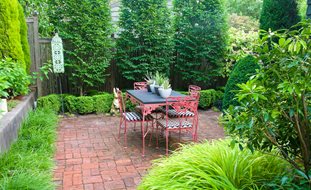How to Grow Black-Eyed Susan Vine
Get tips for planting, caring for, and using this beautiful flowering climber, along with a look at some of our favorite varieties.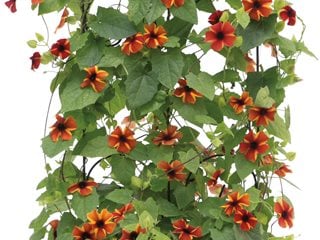
Tangerine Slice A-Peel® black-eyed Susan vine. (Thunbergia alata). Photo by Proven Winners.
It’s always wonderful to discover a plant that can solve a multitude of garden challenges while looking gorgeous at the same time. If you’re not yet familiar with black-eyed Susan vine (Thunbergia alata), it’s time to learn how this versatile tropical flower can work wonders in your garden.
In smaller yards, this fast-growing tender perennial is a great space-saver because it enthusiastically twines up trellises, fences, arbors, and other supports to take advantage of underutilized vertical space. Need to quickly fill in bare spots in your garden? Allow black-eyed Susan vine to ramble unsupported along the ground to create a lovely floral carpet.
If container gardening is your passion, this cheerful dark-eyed bloomer can function as both a thriller and spiller element in pots or hanging baskets, climbing up a support or cascading over the sides, whichever way you let it wander.
And if you’re simply looking for an easy-care flower that will fill your garden with brilliant color from summer well into fall, black-eyed Susan vine is the perfect choice. It comes in an array of eye-catching hues such as lemon yellow, orange, and tangerine, and needs no deadheading to produce masses of long-lasting blooms.
On this page: Basics | Planting | Care | Varieties | Frequently Asked Questions | Design Ideas
On this page:
- BASICS
- PLANTING THUNBERGIA
- BLACK-EYED-SUSAN VINE CARE
- VARIETIES OF THUNBERGIA
- FREQUENTLY ASKED QUESTIONS
- DESIGN IDEAS
BASICS
Botanical name:
Thunbergia alata
Common names:
Black-eyed Susan vine, clock vine, bright eyes
(Note: Although the flowers bear a resemblance to black-eyed Susan (Rudbeckia), the plants are not related.)
Plant type:
Tender perennial, usually grown as an annual
Zones:
10-11
Native area:
East Africa
Exposure:
Full sun to part shade
Method of attachment:
Twining stems
Height:
3 to 8 feet
Bloom time:
Blooms continuously from early summer until frost, usually putting on the best show from late summer to early fall.
Flower colors and characteristics:
Five-petaled flowers, 1 to 2 inches across, come in shades of yellow, orange, red, coral, white, or bicolor, with dark purple or black throats.
Foliage:
Heart-shaped or triangular leaves grow up to 3 inches in length. Color ranges from deep green to gray-green.
HOW TO PLANT BLACK-EYED SUSAN VINE

Photo by Elsa Cadic / Shutterstock
Where to plant:
These plants grow best in a sunny site sheltered from strong winds and drafts. If you live in a hot, dry climate, plant them in a spot that receives some afternoon shade.
When to plant:
For the earliest flowers, start seeds indoors 6 to 8 weeks before your last frost date in spring. You can also start plants from seed sown directly in the garden after the last frost. If growing from transplants, plant them in the spring once the soil has warmed up and nights stay consistently above 50° F.
How to plant:
Set out nursery-grown transplants at the same depth they were growing in the container, spacing them at least a foot apart.
If growing from seeds, plant them about 1/2 inch deep, covering them with a fine layer of soil. Don’t worry if the seedlings take awhile to emerge. Black-eyed Susan seeds often require as long as 21 days to germinate.
If you want your plants to climb a vertical support such as a trellis or plastic netting, install it before planting seeds or transplants so you don’t disturb the young plants.
Soil:
Prefers moist, well-drained, fertile soil that is rich in organic matter. If growing in containers, use a high-quality all-purpose potting mix that drains well.
Tip:
If you want your black-eyed Susan vines to climb a support, they will need a little coaxing to get started. You can secure young shoots to the base of the support with gardener’s wire or coated twist ties until the plant has secured itself. As the vines grow, any stray or wayward shoots can be carefully twisted around the support. Black-eyed Susan vines naturally twine counterclockwise, so keep that in mind when training them.
BLACK-EYED SUSAN VINE CARE
Water:
Like most tropical plants, Thunbergia alata does not tolerate drought. Water regularly throughout the growing season to keep the soil evenly moist but not soggy. Plants grown in containers may need more frequent watering. Wilting foliage is often the first sign that your plants are thirsty.
Amendments and fertilizer:
In the garden, the application of a controlled-release fertilizer at planting time is usually sufficient to keep plants thriving. Also work some compost or other organic matter into the soil to improve drainage and soil fertility.
Container-grown plants will also benefit from the use of a controlled-release fertilizer while plants are in bloom; follow directions on the label. Avoid over-fertilizing, which can inhibit flowering.
Pruning and deadheading:
Light pruning can be done as needed throughout the growing season to help shape plants and manage their size. Deadheading is not necessary to keep these vines in bloom.
Propagation:
By seeds or stem cuttings taken in summer.
Overwintering indoors:
In climates where black-eyed Susan vines aren’t hardy, potted plants can be moved indoors in late fall (or as soon as nighttime temperatures fall below 50 degrees F) and grown in a sunny window as a houseplant. Given enough sun or supplemental artificial lighting, plants may continue to bloom, although not as profusely.
Pests and diseases:
Black-eyed Susan vines are generally not affected by diseases or pests, but plants can occasionally be susceptible to whiteflies and spider mites, especially when grown indoors.
VARIETIES OF BLACK-EYED SUSAN VINE
FREQUENTLY ASKED QUESTIONS
Is black-eyed Susan vine an annual or perennial?
Although usually grown as an annual, it is actually a tender evergreen perennial in frost-free climates (zones 10-11).
Is black-eyed Susan vine fragrant?
The flowers of some varieties have a hint of fragrance, but if you’re looking for a vine that is strongly fragrant, mandevilla, sweet pea, or honeysuckle are good alternatives. Despite the lack of scent, bees and butterflies will still flock to the colorful blooms.
Do black-eyed Susan vines grow fast?
Although they can be slow to germinate, the vines will shoot up quickly once they become established, growing 6 inches or more per week under ideal conditions.
Is black-eyed Susan vine deer resistant?
Because the foliage of Thunbergia is slightly coarse and hairy, it is not very palatable to foraging deer. However, be on the look out for signs of browsing.
Is black-eyed Susan vine poisonous?
No. It’s generally considered to be safe according to the University of California list of safe garden plants. However, consuming any part of the plant is not recommended.
Is black-eyed Susan vine invasive?
Because it self-seeds readily, it can become invasive in tropical, frost-free climates. This is rarely a problem in areas where it’s grown as an annual.
IDEAS FOR USING BLACK-EYED SUSAN VINE
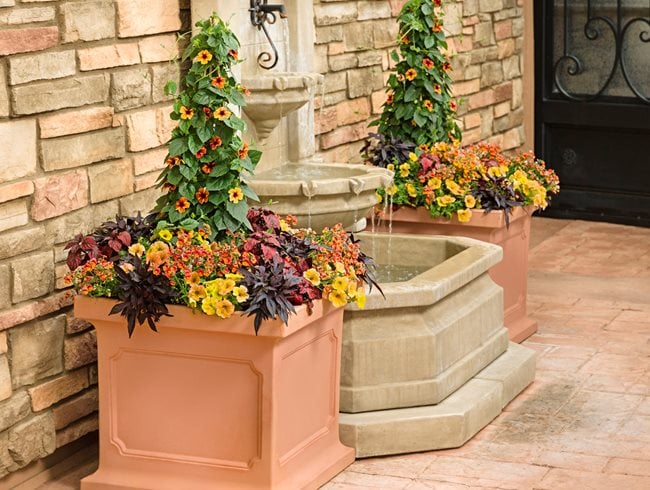
Plant black-eyed Susan vines in containers with other vines and trailing plants like purple sweet potato vine, nemesia, and Supertunias, training it to climb up a tutuer or obelisk for added drama. (See this container recipe.) Photo by Proven Winners.

Allow the vines to weave through a chain-link or latticework fence or even two posts criss-crossed with garden wire to form a quick-growing living wall or privacy screen. Learn how to create your own Thunbergia privacy wall. Photo by Proven Winners.
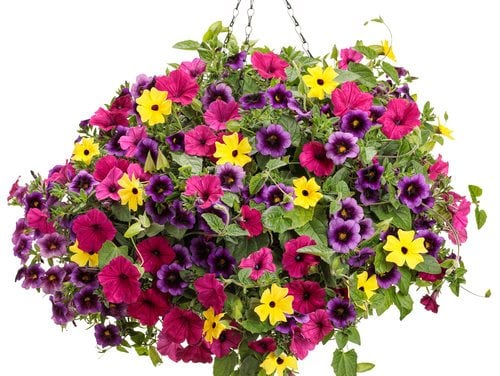
Create an attention-getting hanging basket by combining yellow black-eyed Susan vines with pink petunias and purple calibrachoas. The vines will twine up the basket’s chains as well as spill over sides for a showy thriller/spiller effect. . (See this container recipe.) Photo by Proven Winners.
More ideas:
Grow alongside other annual vines with flowers in contrasting colors, such as purple hyacinth bean or morning glory. As the vines intertwine, they will create a beautiful tapestry of different flower colors and forms.
Allow the vines to wrap around a mailbox pole or lamppost, or use them to hide an old tree stump by encircling the stump with wire netting that the vines can grab onto.
